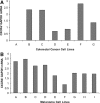Chemokine receptor CXCR4 expression in patients with melanoma and colorectal cancer liver metastases and the association with disease outcome
- PMID: 16794396
- PMCID: PMC1570598
- DOI: 10.1097/01.sla.0000217690.65909.9c
Chemokine receptor CXCR4 expression in patients with melanoma and colorectal cancer liver metastases and the association with disease outcome
Abstract
Objective: To determine the role of chemokine receptor (CR) expression in patients with melanoma and colorectal cancer (CRC) liver metastases.
Summary background data: Murine and in vitro models have identified CR as potential factors in organ-specific metastasis of multiple cancers. Chemokines via their respective receptors have been shown to promote cell migration to distant organs.
Methods: Patients who underwent hepatic surgery for melanoma or CRC liver metastases were assessed. Screening cDNA microarrays of melanoma/CRC cell lines and tumor specimens were analyzed to identify CR. Microarray data were validated by quantitative real-time RT-PCR (qRT) in paraffin-embedded liver metastases. Migration assays and immunohistochemistry were performed to verify CR function and confirm CR expression, respectively.
Results: Microarray analysis identified CXCR4 as the most common CR expressed by both cancers. qRT demonstrated CXCR4 expression in 24 of 27 (89%) melanoma and 28 of 29 (97%) CRC liver metastases. In vitro treatment of melanoma or CRC cells with CXCL12, the ligand for CXCR4, significantly increased cell migration (P < 0.001). Low versus high CXCR4 expression in CRC liver metastases correlated with a significant difference in overall survival (median 27 months vs. 10 months, respectively; P = 0.036). In melanoma, low versus high CXCR4 expression in liver metastases demonstrated no difference in overall survival (median 11 months vs. 8 months, respectively; P = not significant).
Conclusions: CXCR4 is expressed and functional on melanoma and CRC cells. The ligand for CXCR4 is highly expressed in liver and may specifically attract melanoma and CRC CXCR4 (+) cells. Quantitative analysis of CXCR4 gene expression in patients with liver metastases has prognostic significance for disease outcome.
Figures





References
-
- Paget S. The distribution of secondary growths in cancer of the breast. Lancet. 1889;1:571–573. - PubMed
-
- Ewing J. Neoplastic Diseases, ed 6. Philadelphia: Saunders, 1928.
-
- Reynolds T. Why tumors travel to certain sites still puzzles researchers. J Natl Cancer Inst. 1998;90:491–493. - PubMed
-
- Weiss L. Comments on hematogenous metastatic patterns in humans as revealed by autopsy. Clin Exp Metastasis. 1992;10:191–199. - PubMed
-
- Stetler-Stevenson WG, Kleiner DE Jr. Molecular biology of cancer: invasion and metastasis. In: DeVita VT Jr, Hellman S, Rosenberg SA, eds. Cancer: Principles and Practice of Oncology. Philadelphia: Lippincott Williams & Wilkins, 2001:123–136.
Publication types
MeSH terms
Substances
Grants and funding
LinkOut - more resources
Full Text Sources
Other Literature Sources
Medical

